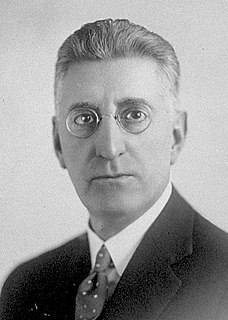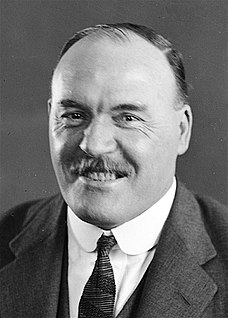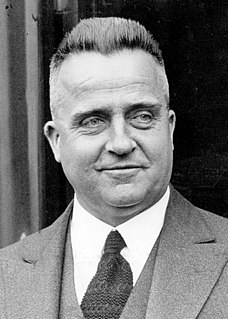
Sir George Foster Pearce KCVO was an Australian politician who served as a Senator for Western Australia from 1901 to 1938. He began his career in the Labor Party but later joined the National Labor Party, the Nationalist Party, and the United Australia Party; he served as a cabinet minister under prime ministers from all four parties.

Thomas Waddell, an Australian politician, was a member of the New South Wales Legislative Assembly from 1887 to 1917, was briefly the premier of New South Wales during 1904, and was a member of the New South Wales Legislative Council from 1917 to 1934. His 75 days in office marks the shortest tenure of any New South Wales premier.

Newcastle is an electoral district of the Legislative Assembly in the Australian state of New South Wales named after and including Newcastle. It is represented since the 2014 Newcastle by-election by Tim Crakanthorp of the Australian Labor Party.

Reginald Walter Darcy Weaver was an Australian conservative parliamentarian who served in the New South Wales Legislative Assembly for 28 years. Serving from 1917 in the backbenches, he entered the cabinet of Thomas Bavin in 1929 as Secretary for Mines and Minister for Forests until he returned to opposition in 1930. Following the success of the United Australia Party in the 1932 election, Weaver returned as the Secretary for Public Works and Minister for Health in the Stevens ministry.
John Charles Lucas Fitzpatrick was an Australian politician and journalist.
This is a list of members of the South Australian House of Assembly from 1930 to 1933, as elected at the 1930 state election:
This is a list of members of the Australian Senate from 1929 to 1932. Half of its members were elected at the 14 November 1925 election and had terms starting on 1 July 1926 and finishing on 30 June 1932; the other half were elected at the 17 November 1928 election and had terms starting on 1 July 1929 and finishing on 30 June 1935. The process for filling casual vacancies was complex. While senators were elected for a six-year term, people appointed to a casual vacancy only held office until the earlier of the next election for the House of Representatives or the Senate.
Members of the New South Wales Legislative Assembly who served in the 29th parliament held their seats from 1930 to 1932. They were elected at the 1930 state election, and at by-elections. The Nationalist Party was replaced by the United Australia Party in 1931. The Speaker was Frank Burke.</ref>

The 1930 New South Wales state election was held on 25 October 1930. The election was conducted in single member constituencies with compulsory preferential voting. The election occurred at the height of the Great Depression and was a landslide victory for the expansionary monetary policies of Jack Lang.

The 1932 New South Wales state election was held on 11 June 1932. This election was for all of the 90 seats in the 30th New South Wales Legislative Assembly and it was conducted in single member constituencies with compulsory preferential voting. It was a landslide victory for the UAP/Country Party coalition of Bertram Stevens, which had a majority of 42 in the Assembly.
Hugh Main was an Australian politician. He was a member of the New South Wales Legislative Assembly from 1920 until 1938, representing the electorates of Cootamundra (1920–1927) and Temora (1927–1938). Initially elected as a Progressive, he was a member of the party's rural "True Blues" faction that by 1927 had evolved into the Country Party.

The Lang ministry (1930–1932) or Third Lang ministry was the 45th ministry of the New South Wales Government, and was led by the 23rd Premier, Jack Lang. This ministry was the third and final time of three occasions where Lang was Premier.

The Stevens–Bruxner ministry (1932–1935) or First Stevens–Bruxner ministry or First Stevens ministry was the 46th ministry of the New South Wales Government, and was led by the 25th Premier, Bertram Stevens, in a United Australia Party coalition with the Country Party, that was led by Lieutenant-Colonel Michael Bruxner, DSO. The ministry was one of three occasions when the Government was led by Stevens, as Premier; and one of four occasions where Bruxner served as Deputy Premier.

The Mair–Bruxner ministry or Mair ministry was the 49th ministry of the New South Wales Government, and was led by the 26th Premier, Alexander Mair, in a United Australia Party coalition with the Country Party, that was led by Michael Bruxner. The ministry was the only occasion when the Government was led by Mair, as Premier; and fourth and final occasion where Bruxner served as Deputy Premier.
Peter Ffrench Loughlin was an Australian politician.

Clarence Goode was a farmer and politician in South Australia. Descendants pronounce the family name to rhyme with "wood".
The National Party was a political party active in South Australia from 1917 to 1923. As with the federal National Labor Party, it was created in the wake of the Australian Labor Party split over conscription, resulting in the February 1917 expulsion from the South Australian Labor Party of the Premier, Crawford Vaughan, and his supporters. It was initially known as the National Labor Party like its federal counterpart, but was renamed at a conference in June 1917. The party initially continued in government under Vaughan, but was subsequently defeated in parliament in July 1917, and thereafter served as the junior partner in a coalition with the Liberal Union under Archibald Peake.
This is a list of members of the South Australian House of Assembly from 1915 to 1918, as elected at the 1915 state election:
Members of the New South Wales Legislative Council who served from 1930 to 1932 were appointed for life by the Governor on the advice of the Premier. This list includes members between the 1930 state election on 25 October 1930 and the 1932 state election on 11 June 1932. The President was Sir John Peden.</ref> The Premier Jack Lang had been seeking to swamp the council, however the Governor Sir Philip Game had declined to do so in November 1930, March, June and September 1931 when Lang sought 70 new members be appointed. In November 1931 Lang dropped his request to 25 new members and the governor agreed to the request. This raised the number of members of the council from 85 to 110.
The Federal Labor Party were the members of the Australian Labor Party in the state of New South Wales who supported the federal party leadership in the split with the state Labor party which broke away in 1931. Federal Labor retained some seats in the Parliament of Australia but was a minor party in state elections. The dispute was healed in 1936.









